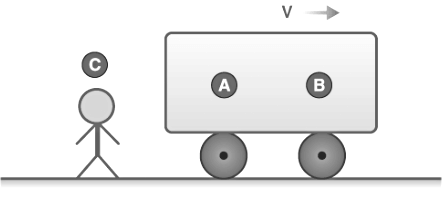Frames of Reference | Physics for EmSAT Achieve PDF Download
Introduction
In our exploration of velocity, acceleration, and displacement, we have encountered the need for a frame of reference from which these quantities are measured.
In the realm of physics, a frame of reference comprises an abstract coordinate system and a collection of physical reference points that establish and standardize measurements within that particular frame.
consider the following figure:

When we inquire about the velocity of object B, individual A would respond that it is stationary. However, if we pose the same question to individual C, their response would indicate that B is in motion with a velocity V in the positive X direction. This disparity in answers highlights the importance of specifying the frame of reference before determining velocity. In other words, defining a frame of reference is necessary to establish a consistent perspective or context.
Types of Frame of Reference
Once we have established our chosen reference point, it can fall into one of two categories:
- Inertial Frame of Reference
- Non-inertial Frame of Reference
Inertial Frame of Reference
- An inertial frame of reference is a frame in which Newton's laws of motion hold true. This implies that if no external forces act upon an object, it will either remain at rest or continue moving at a constant velocity. Consider an object placed on the surface of the Earth. To an observer on Earth, the object appears at rest, while to an observer on the Moon, it appears to be in motion. So, which frame of reference is inertial in this scenario?
- The term "inertial frame" is relative. Initially, we assume a reference frame to be an inertial frame of reference. Therefore, a more general definition of an inertial frame would be: An inertial frame is one that is either at rest or moving at a constant velocity relative to our assumed inertial reference frame.
Non-inertial Frame of Reference
- A non-inertial frame of reference, on the other hand, is a frame that undergoes acceleration relative to the assumed inertial frame of reference. Newton's laws of motion do not hold true in these frames. In the example mentioned above, if we assume Earth to be the inertial reference frame, then the Moon becomes a non-inertial reference frame as it experiences accelerated motion relative to Earth. However, if we wish to apply Newton's laws in this scenario, we must introduce additional mysterious forces known as pseudo-forces.
|
209 videos|327 docs|212 tests
|















